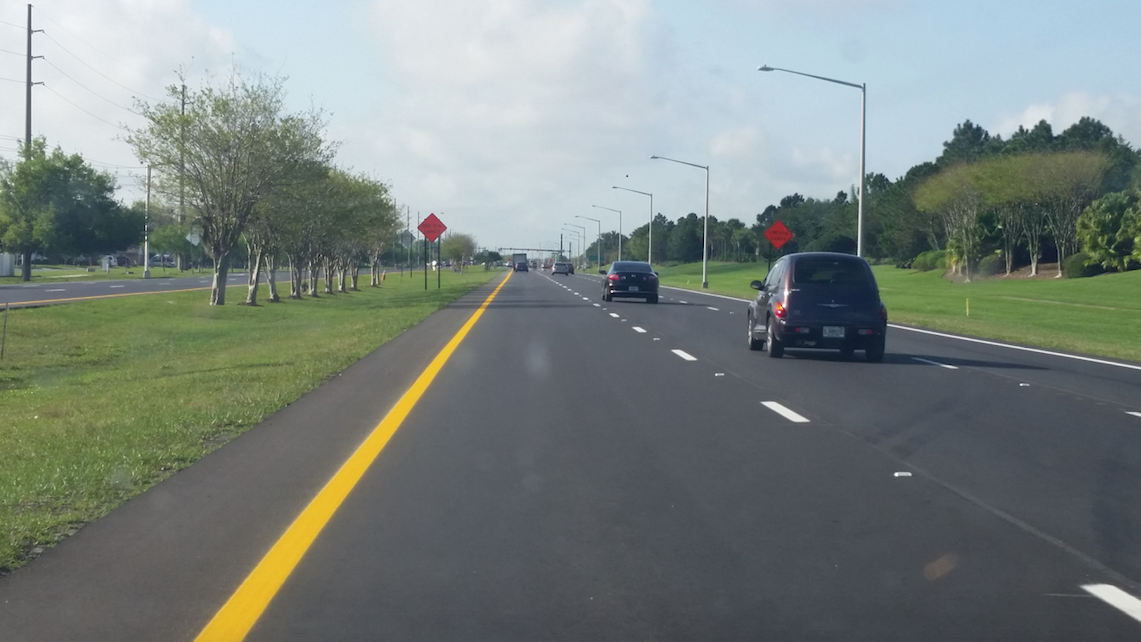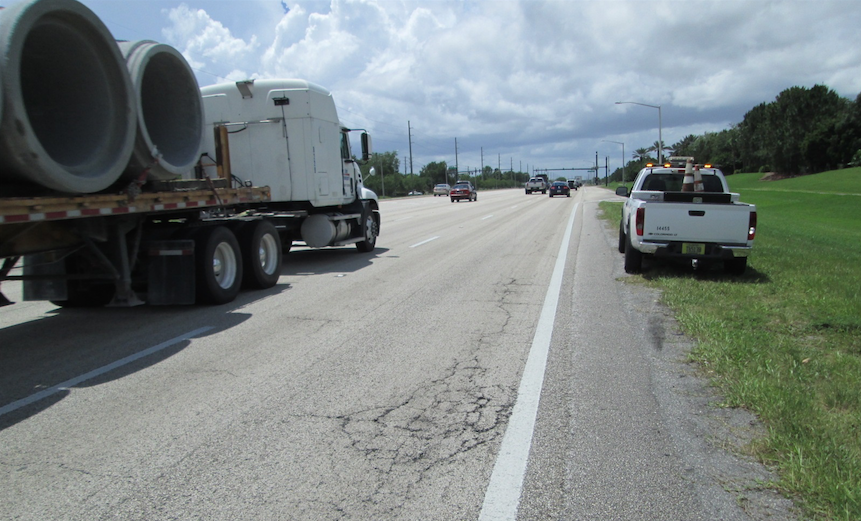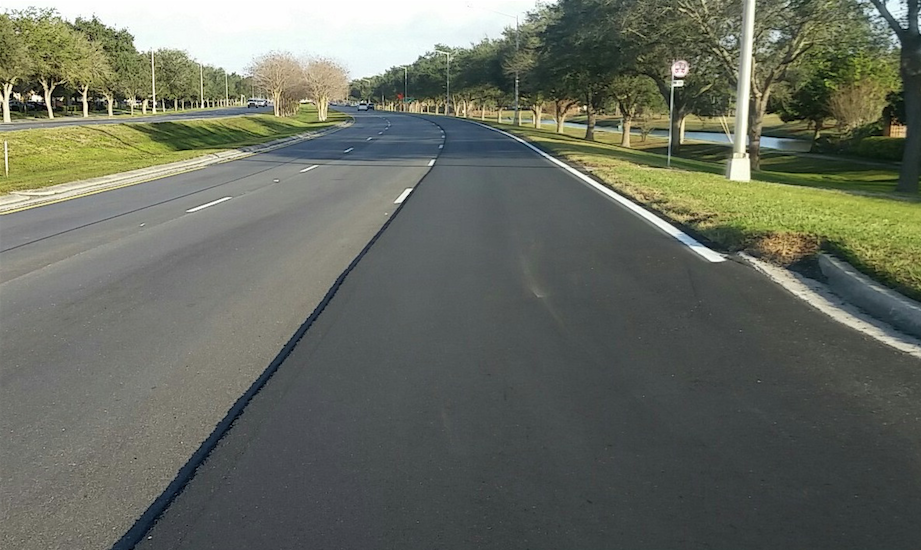Orange County, Middlesex Resurface Major Thoroughfare with Challenges, Success
BY Deodat Budhu

In 1984, construction of the south section of John Young Parkway, a major collector roadway, was initiated to provide access to Interstate 4, northward access to Orange County, interlocal streets, businesses and residents. Throughout the years, the road has been widened by adding turn lanes and extra lanes to accommodate increased traffic capacity stemming from growth and businesses through the corridor.
The section of roadway from just north of SR 528 to the Orange/Osceola County line needed structural course replacement due to pavement degradation. Widening plans for the section north of it delayed the needed repairs. During the years since its original construction, the section has had piecemeal repairs and non-structural preservation to keep the road conforming to an acceptable pavement condition index. In 2004, the section between Central Florida and Whisper Lakes Blvd. was microsurfaced; numerous base repairs were performed intermittently thereafter due to funding hardships and the recession. The section between Sand Lake Rd. and the joint north of SR 528 was finally widened in 2014.
To mitigate further degradation, this six-lane roadway was recommended for full pavement restoration. The original structural pavement was constructed with Marshall mixes with 3 ½-inches of S-III and 5/8-inch of FC-III. Therefore, it was recommended to mill 4 inches of the existing friction and structural courses, perform minor base repairs where needed, restore the 2 1/2 inches of structural course with Superpave SP 12.5 and the friction course 1 ½-inch of Superpave Friction Course 12.5. This proposed pavement structure is expected to bring the roadway back to acceptable standards and provide a useful life of at least 12 years.
Jim Warren, the executive director of the Asphalt Contractors of Florida Association (ACAF), Tallahassee, shared: “Middlesex is an award winning contractor serving central Florida and John Young Parkway is a critical roadway; upgrading it with Superpave is a smart decision. Orange County is a progressive county and always looking to use the best materials and technology.”
The project encompasses 4 miles of resurfacing, a total of 630,000 square yards of pavement (both structural and friction courses), minor base repairs where needed and the placement of permanent pavement markings. To ensure safety during resurfacing operations, temporary pavement markings were also part of the project for an estimated total of $7.4 million. Due to the size of the project, the use of our term contracts was not possible, and the project was independently outsourced.
The lowest bid came in at $6.9 million from Middlesex Corporation; the contract was awarded to them in August 2015. The outsourced milling and resurfacing operations on S. John Young Parkway between the joints north of SR 528 (Beachline) and the Orange/Osceola county line began Aug. 10, 2015, and the projected completion date for the project was April 11, 2016. The team finished early March 28, 2016.

Sections of the roadway see up to 63,381 vehicles per day.
Although the entire south end corridor was scheduled to be upgraded, a separate FDOT project for the widening of SR 528 from I-4 to the Turnpike started in September, and the section of John Young adjacent and under the SR 528 bridge is scheduled for major construction. To avoid conflicts with this upcoming FDOT widening project, the County did not perform milling and resurfacing operations in this area.
In addition, to avoid conflicts with a proposed Orange County Utilities reclaimed water main improvements project, four turn lanes were also skipped during the milling and resurfacing operations.
With an average daily traffic (ADT) increasing from 37,469 in 1999 to 63,381 in 2015 for some sections of this road, dealing with multiple signalized intersections and potential aggravated citizens was the most challenging task for the project. To avoid delays related to inoperative traffic loops, traffic lights were upgraded to video detection prior to starting the milling and resurfacing operations. Similarly, to minimize upset motorists or safety issues, we handled close coordination with commissioners, homeowners associations, the Sheriff’s office, fire department and traffic divisions prior to project commencement. All operations were performed at night, Sunday through Thursday, between 9 p.m. and 6 a.m., starting at the county line and moving north, completing entire lanes of the roadway at a time. Work in progress was closely monitored to limit the length of traffic control based on daily production, keeping the work zone tight. Post-mounted traffic warning signs, “Stay in your lane” and “Uneven Pavement” were in place throughout the project to guide motorists until the friction course was in place. Law enforcement was also present for assistance during night operations.
Middlesex also overcame challenges during operations, from contaminated sections of asphalt to an unfortunate accident.
The contaminated section of asphalt resulted from a few dump trucks transporting millings from the job site and not being properly cleaned before returning with the hot mix. Three very small segments of the paved roadway contaminated with milling fines were milled out and repaved.

These images show the top course, completed by March 28, 2016, two weeks ahead of schedule.
With respect to the accidents, this occurred when one of the 10-wheeler dump trucks transporting asphalt overturned while traversing a curve on the job site. The driver was not injured. The spilled mix was cleaned up, and damaged section of roadway was successfully repaired.
Despite these incidents, the daily production ranged from 700 to 1,100 tons (mill and fill), depending on challenges found in the work area. This allowed the contractor to complete the structural course in approximately three months. The friction course was expected to take approximately 30 days with a range of placement between 1,400 and 1,800 tons per shift. All the milling and structural overlay was completed prior to the Christmas holiday. The friction course was postponed until mid-January 2016. However, the advent of cold weather and rain during the month of January delayed the friction course overlay until the beginning of February. The progress from there was steady and Middlesex completed the contracted work March 28, more than two weeks ahead of schedule.
The project proved that regardless of challenges, proper planning and coordination of resurfacing operations, independent of project size, can be successful. The amount of complaints received from our citizens has remained the same or lower than any of our regular resurfacing projects. The project progressed well and within the allotted time and budget, with a total of 51,976 tons of asphalt laid.
Deodat Budhu, P.E., is the manager of the roads & drainage division of Orange County Public Works Department, Orlando.
